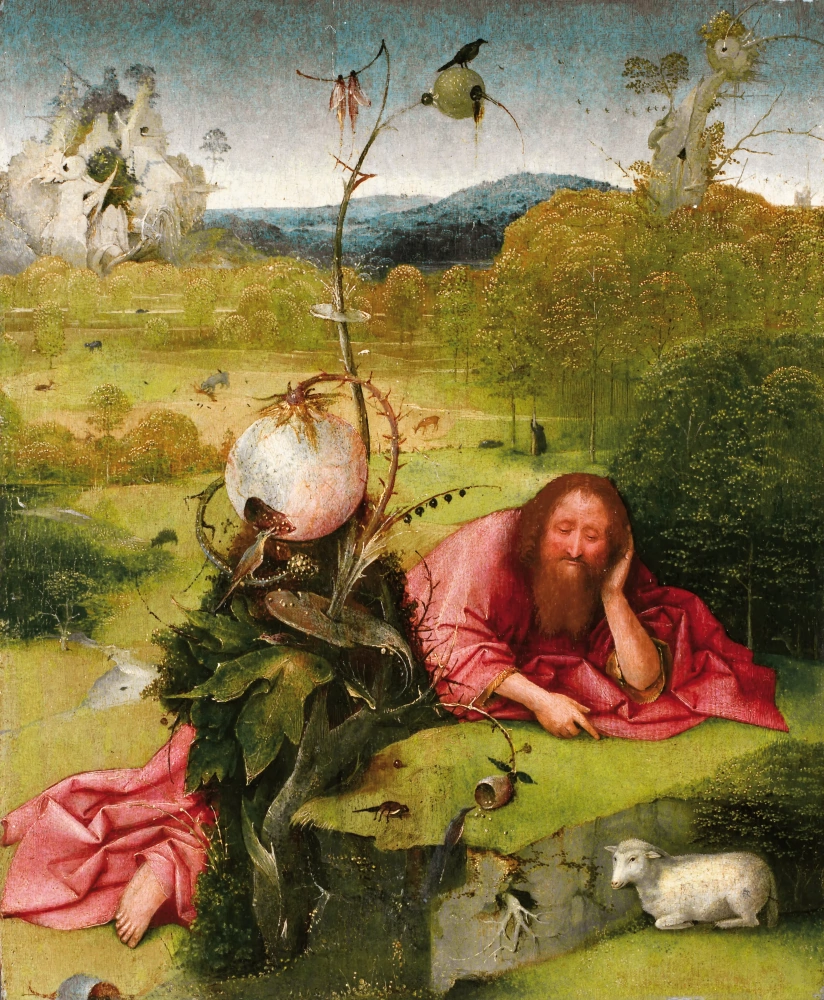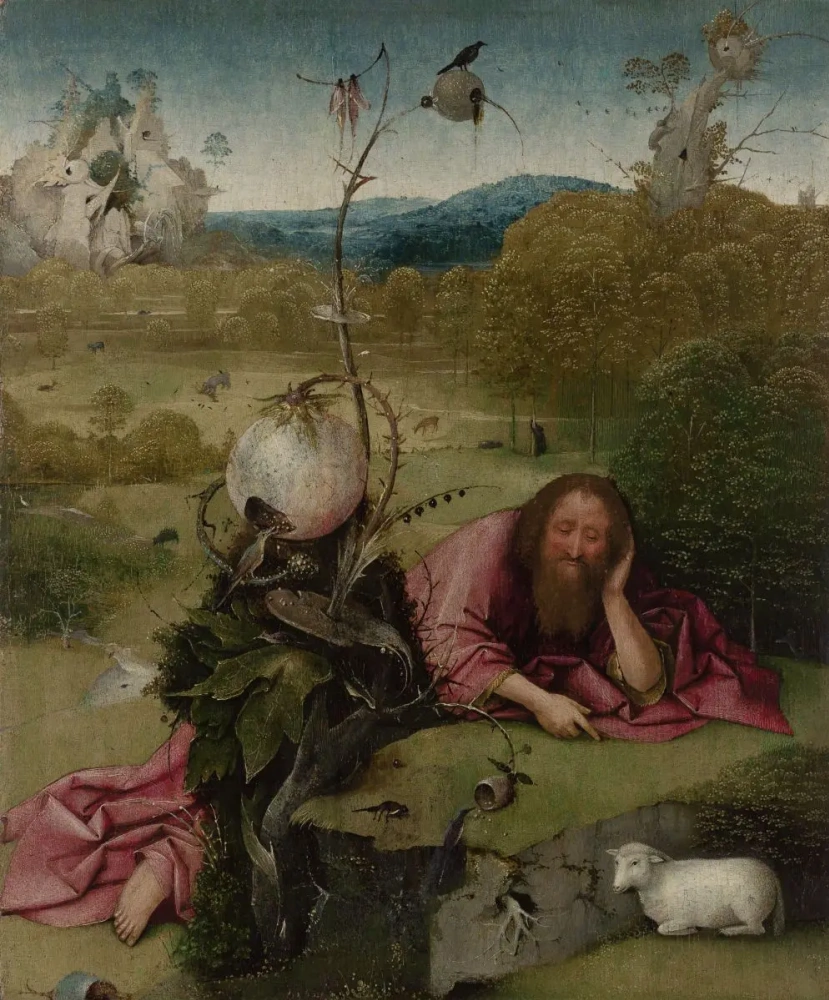log in
Enter site
Login to use Arthive functionality to the maximum
St. John the Baptist in the wilderness
Hieronymus Bosch • Painting, 1489, 48.5×40.5 cm


















Description of the artwork «St. John the Baptist in the wilderness»
The theme of unbridled earthly delights, contrary to popular belief, was not dominant at Bosch. Very often the artist treated themes of Holiness and of prayer, meditation and penance. As an example of a righteous life lived, in the works of Hieronymus Bosch often appear hermits– those who withdrew from the world lying in wickedness, that, left to himself and to God, repent and pray. These are the founder of hermit monks of the Holy Anthonypraying in the desert scribe Jeromeand the gospel John the Baptist.
John the Baptist (John the Baptist), the latest from the biblical prophets a direct precursor of Jesus Christ, whose task was "to prepare the way for Him". John called the people of Israel to repentance and baptized with water, explaining that following him would baptize with the Holy spirit. If Jesus Christ, the Pharisees could accuse that He does not fast, but on the contrary, did not scruple to eat and drink with publicans and sinners, John the Baptist is an image of a perfect ascetic, who lived in the desert, wore a rough woolen cloak and fed on "locusts (locusts) and wild honey."
The modern viewer may have a legitimate question: why is the place where departed John the Baptist, the painting of Hieronymus Bosch, so a little reminiscent of the desert? Indeed, around the green trees and bushes, near the Baptist Matures exotic fruit, and the grass is so green and lush, lying near John lamb certainly does not feel hunger. The fact that in the time of Bosch the word "desert" in the Dutch language was not associated with a barren sand. Rather, it was a deserted area. In the same decade as the painting of Bosch, was written "John The Baptist"another artist from the Netherlands, Gertsena tot Sint Jans. "Desert" also consists of green hills, cut by streams, and beautiful trees.
Critics see the painting of Hieronymus Bosch, "John the Baptist" influence Sint Jans. But if the landscape is entirely realistic, it remains a Bosch Bosch depicts a fantastic characteristic when a plant with thorns, elegantly curving stem and luxury overripe fruit (similar can be found in his other paintings), symbolizing the sweetness of earthly temptations and temptations. Almost always these fruits have a Bosch have a gorgeous shell, like a bright, fragrant and ripe fruit, but a bad-natured and deadly seeds. To avoid doubt, the artist writes three birds: one of them is sitting on the Bud at the upper edge of the painting (it does not bite the fruit of Vice, so she's safe), the second vyklevyvaet mid-ripe fruit, and the third, obviously, recently filled the same food is already dead paws up at the bottom of the stove, upon which John. The leaves of the plant resemble a Thistle – the symbol of original sin. On the spiritual dangers and temptations points and rock with a bizarre shape in the background, reminiscent of "fountains of life" from "The garden of earthly delights".
Perched under the piece of rock white lamb symbolizes Jesus Christ, in accordance with His interpretation of the gospel as the sinless lamb, who is sacrificed to atone for human sins. John the Bosch points to the lamb with your finger. This gesture is a direct picturesque parallel to the words uttered by the Baptist in the gospel of John: "Behold the lamb of God Who takes away the sin of the world" (Jn. 1:29)
Author: Anna Yesterday
John The Baptist
John the Baptist (John the Baptist), the latest from the biblical prophets a direct precursor of Jesus Christ, whose task was "to prepare the way for Him". John called the people of Israel to repentance and baptized with water, explaining that following him would baptize with the Holy spirit. If Jesus Christ, the Pharisees could accuse that He does not fast, but on the contrary, did not scruple to eat and drink with publicans and sinners, John the Baptist is an image of a perfect ascetic, who lived in the desert, wore a rough woolen cloak and fed on "locusts (locusts) and wild honey."
Landscape
The modern viewer may have a legitimate question: why is the place where departed John the Baptist, the painting of Hieronymus Bosch, so a little reminiscent of the desert? Indeed, around the green trees and bushes, near the Baptist Matures exotic fruit, and the grass is so green and lush, lying near John lamb certainly does not feel hunger. The fact that in the time of Bosch the word "desert" in the Dutch language was not associated with a barren sand. Rather, it was a deserted area. In the same decade as the painting of Bosch, was written "John The Baptist"another artist from the Netherlands, Gertsena tot Sint Jans. "Desert" also consists of green hills, cut by streams, and beautiful trees.
Critics see the painting of Hieronymus Bosch, "John the Baptist" influence Sint Jans. But if the landscape is entirely realistic, it remains a Bosch Bosch depicts a fantastic characteristic when a plant with thorns, elegantly curving stem and luxury overripe fruit (similar can be found in his other paintings), symbolizing the sweetness of earthly temptations and temptations. Almost always these fruits have a Bosch have a gorgeous shell, like a bright, fragrant and ripe fruit, but a bad-natured and deadly seeds. To avoid doubt, the artist writes three birds: one of them is sitting on the Bud at the upper edge of the painting (it does not bite the fruit of Vice, so she's safe), the second vyklevyvaet mid-ripe fruit, and the third, obviously, recently filled the same food is already dead paws up at the bottom of the stove, upon which John. The leaves of the plant resemble a Thistle – the symbol of original sin. On the spiritual dangers and temptations points and rock with a bizarre shape in the background, reminiscent of "fountains of life" from "The garden of earthly delights".
Lamb
Perched under the piece of rock white lamb symbolizes Jesus Christ, in accordance with His interpretation of the gospel as the sinless lamb, who is sacrificed to atone for human sins. John the Bosch points to the lamb with your finger. This gesture is a direct picturesque parallel to the words uttered by the Baptist in the gospel of John: "Behold the lamb of God Who takes away the sin of the world" (Jn. 1:29)
Author: Anna Yesterday
Publications about the artwork






